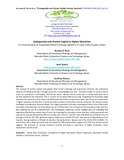| dc.contributor.author | Sirak, Seroney k. | |
| dc.contributor.author | Ejakait, Epari | |
| dc.contributor.author | Musera, Geoffrey | |
| dc.date.accessioned | 2022-11-16T09:00:41Z | |
| dc.date.available | 2022-11-16T09:00:41Z | |
| dc.date.issued | 2022-10-15 | |
| dc.identifier.uri | https://doi.org/10.35544/jjeoshs.v5i1.48 | |
| dc.identifier.uri | https://www.jumugajournal.org/index.php/jjeoshs/article/view/48 | |
| dc.identifier.uri | http://ir-library.mmust.ac.ke:8080/xmlui/handle/123456789/2137 | |
| dc.description.abstract | The concept of human capital presupposes that formal schooling and experience enhances the productive capacity of individual workers through acquisition of knowledge and skills. Empirical studies on private rate of return to investment in education, around the world, indicate that an extra year in formal education has a positive benefit to the individual. This is in terms of increased lifetime earnings. Employing the Mincerian wage equation, this research article seeksto establish and empirically compare the private rate of return to investment in higher education for teachers in public secondary schools in Uasin Gishu County of Kenya. The research article employed a comparative research design. The target population and data sampling was taken from all the public secondary school teachers from the above County. Primary data from a sample of 574 secondary school teachers was collected by use of a questionnaire. The multivariate regression results showed years of schooling that negatively affected the private rate of return to schooling for secondary school teachers; while experience and experience squared had positive effect on private rate of return. Teachers who hold Diploma certificates earn an average of Kshs31, 231.250, Bachelor’s degree holders earn Kshs54, 047.879. The mean earning difference from teachers having Diploma certificates to teachers having Bachelor’s degrees was Kshs 22,816.629 (73.06%). The rate of return for a Diploma teacher was calculated at 4.20% and Bachelor’s degree at 8.37%. This research article suggests the presence of varying monetary benefits accruing to investment in higher education. Policy implications are discussed. | en_US |
| dc.language.iso | en | en_US |
| dc.publisher | JUMUGA Journal of Education, Oral studies and human science | en_US |
| dc.subject | Endogeneity, Human Capital, Higher Education, Critical Analysis, Investment Returns, Teacher’s | en_US |
| dc.title | Endogeneity and Human Capital in Higher Education A Critical Analysis of Investment Returns Among Teacher’s in Uasin Gishu County, Kenya | en_US |
| dc.type | Article | en_US |

